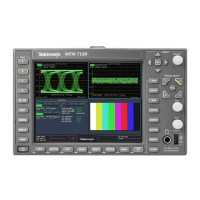Theory of Operat ion
Audio Processing
Both audio vers
ions have the same basic processing engine. This uses an FPGA to
route the audio input into two DSP chips, whose main function is to calculate the
peak values for the selected meter ballistics (response characteristics).
The audio data has two paths to the d isplay. On one path, peak values are sent
to the control processor which then plots the bar and surround displays. On the
second path, raw data samples are sent to the waveform processing engine which
interpolates and plots it to generate the lissajous, or “phase,” display.
Audio Inputs
There are three basic audio input paths: AES, analog, and embedded. AES inputs
are accepted at rates up to 192 kHz.
Analog inputs are digitized at 48 kHz and then go through the same path as the
AES inputs.
The embedded audio path starts at the waveform processing engine. First the
audio samples are extracted from the serial digital video data using a 12.288 MHz
oscillator and sent to the audio board. A t the audio board the streams are
multiplexed into the AES d ecoders and then follow the same p ath as the AES data.
The us
er can choose to have the de-embedded audio output on the AES B port.
Audio Outputs
There are two audio outputs: Analog and AES. Both outputs always follow the
source that is currently selected for the audio bar display. The analog outputs can
come
from any input. The selected signal output from the FPGA is converted
from digital to analog, and then sent as a balanced output to the 62-pin rear panel
analog audio connector.
The AES B connectors can be configured as outputs for use with any input type.
They can serve as an active loopthrough if the input is AES, a de-embedder if the
input is embedded, or an A/D converter if the input is analog. Up to six decoded
Dolby audio channels may be output if Option DDE is installed.
O
ption EYE/PHY
Option EYE is for basic SDI signal monitoring, providing Eye pattern displays
and readouts of jitter and key c able parameters. Option PHY has these same
capabilities, plus jitter waveform display and automated Eye parameter
measurements. Options EYE and PHY provide the following features:
Eye pattern display
Equalized Eye p attern display
Jitter readout
Jitter Meter
Cable Loss readout
WFM6120, WFM7020, and WFM7120 Waveform Monitors Service Manual 2–5





